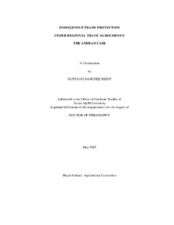| dc.contributor.advisor | Bessler, David A. | |
| dc.creator | Sanchez Bizot, Gustavo | |
| dc.date.accessioned | 2006-08-16T19:03:15Z | |
| dc.date.available | 2006-08-16T19:03:15Z | |
| dc.date.created | 2005-05 | |
| dc.date.issued | 2006-08-16 | |
| dc.identifier.uri | https://hdl.handle.net/1969.1/3780 | |
| dc.description.abstract | Endogenous tariff formation has been the subject of theoretical studies that attempt to
determine the fundamental economic variables that influence the structure of industry
protection implemented by international trade policy makers. An empirical analysis of
endogenous tariff formation under the framework of a regional trade agreement
implemented by the Andean Community Group is offered in this dissertation.
Econometric models for the groupÂ’s common external tariff (CET) and for individual
country tariff deviations with respect to the CET are estimated. The analysis is based on
cross-sectional industrial and trade data for 1996, collected at four digit level of
aggregation. The level of aggregation refers to the specific definition of industrial sectors
included in the International Standard Industrial Code (ISIC). While previous studies on
another regional integrated group in South America (MERCOSUR) use data at the three
digit level, the aggregation used in this research implies a significant increase in the sample size, and also a more homogeneous specification regarding the composition of
the industrial sectors under analysis.
The causal links among the variables are obtained by using the directed acyclical graphs
(DAGs) approach. This allows for a refined search for causal relationships. The
approach is particularly appealing for the analysis of endogenous trade protection since
it allows analyzing economic systems that involve policy intervention.
The empirical analysis supports several of the classic theoretical models on trade
protection. The results are consistent with the equity concern model, which suggests that
governments tend to protect industrial sectors that employ a significant number of low
wage unskilled workers. The estimated models also support the interest group and the
adding machine theoretical formulations. However, a rather interesting result derived
from the DAG analysis is the feedback interaction that seems to operate between tariffs
and policy variables. The current literature restricts the estimation of trade protection by
imposing tariffs as the dependent variable with no reverse effect from this variable to the
policy variables. Our results challenge this unidirectional causality view, since an effect
from tariffs to the policy variables shows up in most of the estimated specifications. | en |
| dc.format.extent | 595374 bytes | en |
| dc.format.medium | electronic | en |
| dc.format.mimetype | application/pdf | |
| dc.language.iso | en_US | |
| dc.publisher | Texas A&M University | |
| dc.subject | Trade protection | en |
| dc.title | Endogenous trade protection under regional trade agreements: the Andean case | en |
| dc.type | Book | en |
| dc.type | Thesis | en |
| thesis.degree.department | Agricultural Economics | en |
| thesis.degree.discipline | Agricultural Economics | en |
| thesis.degree.grantor | Texas A&M University | en |
| thesis.degree.name | Doctor of Philosophy | en |
| thesis.degree.level | Doctoral | en |
| dc.contributor.committeeMember | Baltagi, Badi H. | |
| dc.contributor.committeeMember | Capps, Jr. Oral | |
| dc.contributor.committeeMember | Leatham, David J. | |
| dc.type.genre | Electronic Dissertation | en |
| dc.type.material | text | en |
| dc.format.digitalOrigin | born digital | en |


